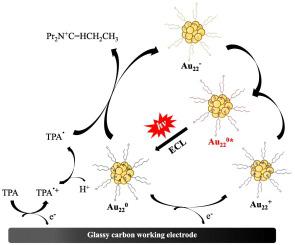当前位置:
X-MOL 学术
›
J. Electroanal. Chem.
›
论文详情
Our official English website, www.x-mol.net, welcomes your
feedback! (Note: you will need to create a separate account there.)
Near-infrared electrogenerated chemiluminescence of Au22(glutathione)18 nanoclusters in aqueous solution and its analytical application
Journal of Electroanalytical Chemistry ( IF 4.1 ) Pub Date : 2021-01-01 , DOI: 10.1016/j.jelechem.2020.114851 Jaeyoon Kim , Kyunglim Pyo , Dongil Lee , Won-Yong Lee
Journal of Electroanalytical Chemistry ( IF 4.1 ) Pub Date : 2021-01-01 , DOI: 10.1016/j.jelechem.2020.114851 Jaeyoon Kim , Kyunglim Pyo , Dongil Lee , Won-Yong Lee

|
Abstract Gold nanoclusters (AuNCs) have attracted great attention in analytical sciences because they have unique optical and electrochemical properties with low biological toxicity. However, the analytical application of Au NCs-based electrogenerated chemiluminescence (ECL) still remains relatively unexplored largely due to their low ECL efficiency in aqueous solution. Moreover, the precise information of molecular formula of Au NCs have not been determined in large number of reports. In the present study, the ECL behavior of atomically precise Au22(SG)18 NCs, where SG is glutathione, were characterized in the aqueous solution. The oxidation of Au22(SG)18 NCs together with coreactant tripropylamine (TPA) at the working electrode potential of 1.25 V vs Ag/AgCl (3 M NaCl) has led to strong ECL emission at ~767 nm in the near-infrared region. The ECL intensity of the Au22(SG)18 NCs was about 14-fold higher than the ECL intensity obtained with the Au@BSA NCs, which is most commonly used Au NCs in aqueous solution. The ECL intensity is strongly dependent upon the concentrations of Au22(SG)18 NCs and TPA. However, the ECL intensity of Au22(SG)18 NCs with TPA is diminished in the presence of phenolic compounds depending upon their concentrations. Using catechol as a model analyte, the present ECL system can detect it in the linear range from 1.0 × 10−7 to 1.0 × 10−4 M with a detection limit of 3.3 × 10−9 M (S/N = 3). The present study has demonstrated the potential application of the Au NCs-based ECL in real analytical problems.
中文翻译:

Au22(谷胱甘肽)18纳米团簇在水溶液中的近红外电致化学发光及其分析应用
摘要 金纳米团簇(AuNCs)由于具有独特的光学和电化学性质以及低生物毒性而在分析科学中引起了极大的关注。然而,基于 Au NCs 的电致化学发光 (ECL) 的分析应用仍然相对未开发,这主要是由于它们在水溶液中的 ECL 效率低。此外,大量报道并未确定 Au NCs 分子式的准确信息。在本研究中,在水溶液中表征了原子级精确 Au22(SG)18 NCs 的 ECL 行为,其中 SG 是谷胱甘肽。Au22(SG)18 NCs 与共反应物三丙胺 (TPA) 在 1.25 V 相对于 Ag/AgCl (3 M NaCl) 的工作电极电位下的氧化导致近红外区域~767 nm 处的强 ECL 发射。Au22(SG)18 NCs 的 ECL 强度比 Au@BSA NCs 获得的 ECL 强度高约 14 倍,Au@BSA NCs 是水溶液中最常用的 Au NCs。ECL 强度很大程度上取决于 Au22(SG)18 NCs 和 TPA 的浓度。然而,在酚类化合物存在的情况下,含有 TPA 的 Au22(SG)18 NCs 的 ECL 强度会降低,具体取决于它们的浓度。使用邻苯二酚作为模型分析物,本 ECL 系统可以在 1.0 × 10−7 到 1.0 × 10−4 M 的线性范围内对其进行检测,检测限为 3.3 × 10−9 M (S/N = 3)。本研究证明了基于 Au NCs 的 ECL 在实际分析问题中的潜在应用。这是水溶液中最常用的Au NCs。ECL 强度很大程度上取决于 Au22(SG)18 NCs 和 TPA 的浓度。然而,在酚类化合物存在的情况下,含有 TPA 的 Au22(SG)18 NCs 的 ECL 强度会降低,具体取决于它们的浓度。使用邻苯二酚作为模型分析物,本 ECL 系统可以在 1.0 × 10−7 到 1.0 × 10−4 M 的线性范围内对其进行检测,检测限为 3.3 × 10−9 M (S/N = 3)。本研究证明了基于 Au NCs 的 ECL 在实际分析问题中的潜在应用。这是水溶液中最常用的Au NCs。ECL 强度很大程度上取决于 Au22(SG)18 NCs 和 TPA 的浓度。然而,在酚类化合物存在的情况下,含有 TPA 的 Au22(SG)18 NCs 的 ECL 强度会降低,具体取决于它们的浓度。使用邻苯二酚作为模型分析物,本 ECL 系统可以在 1.0 × 10−7 到 1.0 × 10−4 M 的线性范围内对其进行检测,检测限为 3.3 × 10−9 M (S/N = 3)。本研究证明了基于 Au NCs 的 ECL 在实际分析问题中的潜在应用。目前的 ECL 系统可以在 1.0 × 10−7 到 1.0 × 10−4 M 的线性范围内对其进行检测,检测限为 3.3 × 10−9 M (S/N = 3)。本研究证明了基于 Au NCs 的 ECL 在实际分析问题中的潜在应用。目前的 ECL 系统可以在 1.0 × 10−7 到 1.0 × 10−4 M 的线性范围内对其进行检测,检测限为 3.3 × 10−9 M (S/N = 3)。本研究证明了基于 Au NCs 的 ECL 在实际分析问题中的潜在应用。
更新日期:2021-01-01
中文翻译:

Au22(谷胱甘肽)18纳米团簇在水溶液中的近红外电致化学发光及其分析应用
摘要 金纳米团簇(AuNCs)由于具有独特的光学和电化学性质以及低生物毒性而在分析科学中引起了极大的关注。然而,基于 Au NCs 的电致化学发光 (ECL) 的分析应用仍然相对未开发,这主要是由于它们在水溶液中的 ECL 效率低。此外,大量报道并未确定 Au NCs 分子式的准确信息。在本研究中,在水溶液中表征了原子级精确 Au22(SG)18 NCs 的 ECL 行为,其中 SG 是谷胱甘肽。Au22(SG)18 NCs 与共反应物三丙胺 (TPA) 在 1.25 V 相对于 Ag/AgCl (3 M NaCl) 的工作电极电位下的氧化导致近红外区域~767 nm 处的强 ECL 发射。Au22(SG)18 NCs 的 ECL 强度比 Au@BSA NCs 获得的 ECL 强度高约 14 倍,Au@BSA NCs 是水溶液中最常用的 Au NCs。ECL 强度很大程度上取决于 Au22(SG)18 NCs 和 TPA 的浓度。然而,在酚类化合物存在的情况下,含有 TPA 的 Au22(SG)18 NCs 的 ECL 强度会降低,具体取决于它们的浓度。使用邻苯二酚作为模型分析物,本 ECL 系统可以在 1.0 × 10−7 到 1.0 × 10−4 M 的线性范围内对其进行检测,检测限为 3.3 × 10−9 M (S/N = 3)。本研究证明了基于 Au NCs 的 ECL 在实际分析问题中的潜在应用。这是水溶液中最常用的Au NCs。ECL 强度很大程度上取决于 Au22(SG)18 NCs 和 TPA 的浓度。然而,在酚类化合物存在的情况下,含有 TPA 的 Au22(SG)18 NCs 的 ECL 强度会降低,具体取决于它们的浓度。使用邻苯二酚作为模型分析物,本 ECL 系统可以在 1.0 × 10−7 到 1.0 × 10−4 M 的线性范围内对其进行检测,检测限为 3.3 × 10−9 M (S/N = 3)。本研究证明了基于 Au NCs 的 ECL 在实际分析问题中的潜在应用。这是水溶液中最常用的Au NCs。ECL 强度很大程度上取决于 Au22(SG)18 NCs 和 TPA 的浓度。然而,在酚类化合物存在的情况下,含有 TPA 的 Au22(SG)18 NCs 的 ECL 强度会降低,具体取决于它们的浓度。使用邻苯二酚作为模型分析物,本 ECL 系统可以在 1.0 × 10−7 到 1.0 × 10−4 M 的线性范围内对其进行检测,检测限为 3.3 × 10−9 M (S/N = 3)。本研究证明了基于 Au NCs 的 ECL 在实际分析问题中的潜在应用。目前的 ECL 系统可以在 1.0 × 10−7 到 1.0 × 10−4 M 的线性范围内对其进行检测,检测限为 3.3 × 10−9 M (S/N = 3)。本研究证明了基于 Au NCs 的 ECL 在实际分析问题中的潜在应用。目前的 ECL 系统可以在 1.0 × 10−7 到 1.0 × 10−4 M 的线性范围内对其进行检测,检测限为 3.3 × 10−9 M (S/N = 3)。本研究证明了基于 Au NCs 的 ECL 在实际分析问题中的潜在应用。











































 京公网安备 11010802027423号
京公网安备 11010802027423号